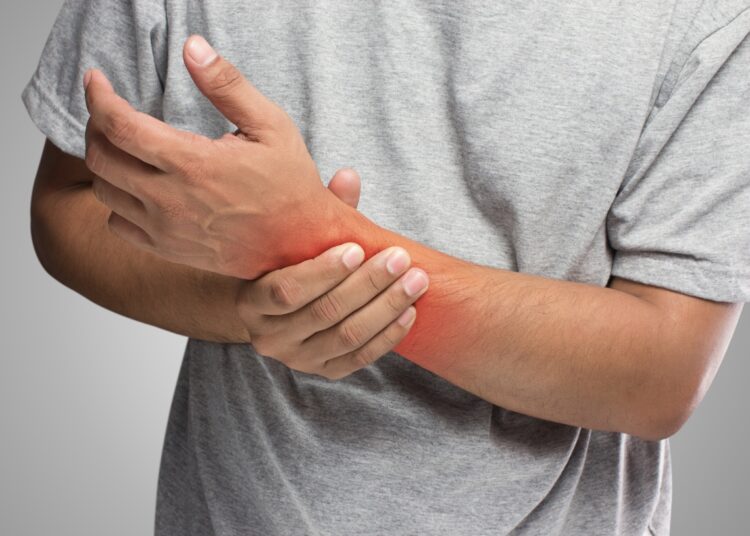Feeling pain keeps us alive; so much so that a rare condition known as congenital insensitivity to pain is associated with a marked decrease in quality of life. According to a specialized publication, people who suffer from it suffer continuous bruises, fractures, joint changes, and burns because they don’t know when they are hurting themselves.
The discovery that the cause of this condition was certain mutations in the genes that encode a group of molecules known as voltage-gated sodium (VgS) channels, after 25 years of research, led to the approval of a unique pain reliever: Suzetrigine. All of this has generated enormous interest in the medical community due to the importance of analgesics in this field of science.
Fighting pain
According to a specialized publication, an analgesic is a drug that helps relieve or reduce pain. For 1,500 years, ancestral magical practices have been complemented by the use of plants such as opium, poppy, mandrake, and, in the Americas, coca leaves, for their analgesic effects.
In the first half of the 19th century, substances such as morphine and ether began to be produced. This led to the emergence and rapid advancement of anesthesiology, surgery, and pain relief in general.
But what is pain? OnCuba had the opportunity to speak with Dr. Carlos Peña, a Second-Degree Specialist in Anesthesia, Resuscitation, and Pain Relief and head of the Anesthesiology Department at the Lucía Íñiguez Clinical and Surgical Hospital in Holguín. According to the expert, pain is an unpleasant sensory and emotional experience related to potential or actual tissue damage.
According to Dr. Peña, there are several ways to classify pain. One of the most commonly used is based on its intensity. This classification divides pain into three levels:
- Mild pain: Pain that does not impede daily activities and can be relieved with medications such as paracetamol or ibuprofen, which belong to the group of nonsteroidal anti-inflammatory drugs (NSAIDs).
- Moderate pain: Pain that interferes with, but does not completely impede, daily activities and, due to its intensity, requires the use of mild opiates such as tramadol and codeine. An example of moderate pain could be that secondary to a herniated disc.
- Severe pain: This is disabling and affects all areas of life, including sleep. In these cases, the use of major opiates such as morphine, fentanyl, or methadone is necessary. A common example of this type of pain is that which occurs in patients with end-stage cancer.
Analgesics and the fentanyl crisis
Relieving mild pain is not a serious problem. According to Dr. Carlos Peña, NSAIDs and other analgesics, although they can cause some adverse reactions, usually mild, are safe for most people.
For patients with severe pain, there is no choice but to turn to major opiates, such as morphine. These patients, seriously ill or in the final stages of a chronic disease, constitute a relatively small group with a limited life expectancy.
The same is not true for patients with moderate pain, especially when the cause is difficult to treat and the need for painkillers becomes routine. This led the pharmaceutical industry to develop drugs derived from opiates, which has generated a true health crisis in the United States, known as the opioid crisis.
This crisis began in the second half of the 1990s, with the marketing of OxyContin or oxycodone hydrochloride, a drug used to relieve moderate to severe pain. At that time, the pharmaceutical industry used misleading messages to promote the prescription of these drugs to patients with chronic pain, which generated the crisis.
According to a BBC article, between 1999 and 2019, 500,000 people died in the United States from opioid overdoses, making it the leading cause of overdose death. The pandemic only exacerbated the problem, and opioid addiction grew by 34% between 2019 and 2020.
According to a CNN report, between 2022 and 2023, 119,000 people died from this cause. Although the number of deaths decreased significantly, 55,000 people died from this cause in 2024.
Furthermore, the challenge of offering a therapeutic option to patients with moderate-intensity pain that doesn’t lead to addiction is more present than ever. It is precisely in this context that the FDA approval of Suzetrigine, commercially known as Journavx, was announced.
First “one-of-a-kind” pain reliever in 25 years
According to another article, Suzetrigine inhibits the entry of sodium into cells specialized in recognizing painful stimuli. How does it do this? It is thanks to the inhibition of voltage-gated sodium channels (VGSCs) that we mentioned at the beginning of the article. Neuronal cells, to transmit electrical impulses, depend on the entry and exit of certain ions, such as Ca2+, K+, and Na+. VGSCs regulate the entry of Na+ into cells, interrupting the transmission of nerve impulses when they are inhibited.
There are different types of VGSCs, and not all are exclusively related to the regulation of painful stimuli. For example, VgS 1.5 is crucial in the transmission of electrical impulses in the heart, allowing the cardiac muscle (myocardium) to contract and pump blood throughout the body.
This is why some local anesthetics, such as lidocaine, are used in the treatment of cardiac arrhythmias. In fact, sodium channel blockers constitute a family of drugs for the treatment of these cardiac rhythm disturbances.
However, the drug in question selectively inhibits VgS 1.8 channels, and has been shown, according to an article published on the website of the Spanish Society of Pharmacology, to reduce pain in patients undergoing abdominal surgery like that of a mixture of hydrocodone (an opiate) and paracetamol.
Additionally, the safety profile of these drugs is very good. Researchers found only mild adverse reactions, such as constipation and headache. All of this led to the FDA’s approval of the drug at the end of January, which could represent a paradigm shift in the treatment of moderate pain, as it is an intermediate option between NSAIDs and other conventional painkillers and opioids.
A sacred duty and a multi-million-dollar prize
According to Dr. Carlos Peña, relieving patients’ pain is a sacred duty for doctors. That is why, according to the expert, it is so important to have an effective drug for the relief of this symptom, one that also does not cause the adverse reactions that have led to the opioid crisis in the United States and other countries.
Furthermore, it opens the door to a new family of painkillers, for the first time in more than two decades. Of course, Suzetrigine’s journey is just beginning: new studies will be conducted to confirm whether what is known so far is correct, and to gather additional information to determine in which pathologies this drug and others in its family, which will likely be developed, may be most useful.
The interest generated is not only due to altruistic reasons: a market worth $115 billion by 2032 seems within reach for Vertex, the company that developed the drug, according to a specialized publication. And, like everything in life, the noblest reasons are related to economic interest, in this case, for the good of humanity.










